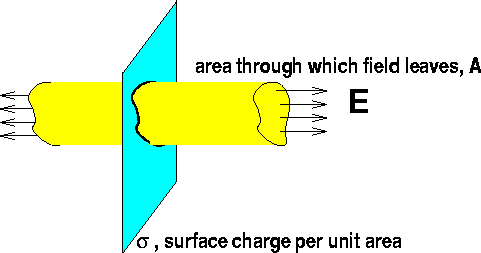Spherically symmetric charge distributions .
Choose the Gaussian surface to be a sphere. The area of the
surface is 4p
r2, so
Gauss's law says
4p
r2 E =
4p
k Q. That implies
E = k Q / r2 where Q is the charge
inside the chosen radius r.
For a point charge, this just gives good old Coulomb's law.
For a charge Q uniformly distributed over the surface of a sphere of radius R, it says that the field inside that sphere (r < R) is zero, and the field outside it is just like that due to a point charge at its center. (Maybe you recall learning a similar result for gravity last semester.)
A
large plate with uniform charge density.
Consider the plate below, which we will assume is
infinite (a good assumption if you are close to the
plate) and has a uniform charge per unit area,
sigma.

Gauss's law states
(remember the field leaves through both sides):
 |
Two
oppositely charged parallel plates.
If you have two plates with opposite charge, as in the
parallel plate capacitor, the
electric fields would add together to give twice this value
in between the
plates,  ,and zero outside.
The field between the plates can also be written as
E = 4 pi k q / a, where q is the charge on
one plate, and a is the area of one plate.
,and zero outside.
The field between the plates can also be written as
E = 4 pi k q / a, where q is the charge on
one plate, and a is the area of one plate.
An
infinite line charge. (Not discussed this year)
Drawing a cylinder of length L around an
infinite wire, which has a charge per unit length of l, will trap a charge inside of Q=lL, and the area through which the
flux leaves is 2prL. Gauss's law then
states:
 |